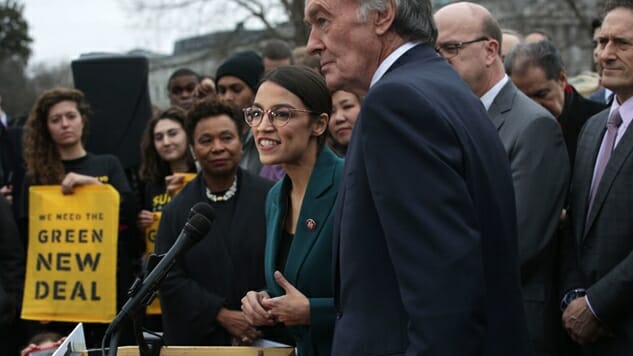What Is Modern Monetary Theory and Why Is It So Important to the Green New Deal?
Photo by Alex Wong/Getty
There is a new economic theory that has emerged on the left called Modern Monetary Theory (MMT). It is basically the opposite of conservative austerity economics. While Reaganites will argue that you must cut government spending to help grow the economy, MMT adherents assert that currency itself is a public monopoly, and so the only limit to government spending is inflation, not the total money the government is taking in, since if the government ever needs more money, it can just print it, because there is no other competition for spending in the economy.
This matters now because the Green New Deal has finally manifested in legislation co-sponsored by top 2020 contenders like Kamala Harris, Bernie Sanders, Kirsten Gillibrand, Cory Booker, and Elizabeth Warren. Alexandria Ocasio-Cortez’s companion Q&A cites two pieces, one in Forbes and the other in Huffington Post, which assert that the question of “how do you pay for the Green New Deal?” has already been answered. The HuffPo piece was written by Professor of Economics and Public Policy at Stony Brook University, Stephanie Kelton, who was also the Chief Economist for the Democrats on the U.S. Senate Budget Committee. Yesterday, she posted a thread outlining some legitimate economic questions that MMT claims to answer.
Q: Are you saying the government can just “print the money” to pay for new spending?
A: Is there any other way?— Stephanie Kelton (@StephanieKelton) February 7, 2019
Q: But that’s deficit spending, so now you have add to the national debt.
A: Except the $ to buy the bonds comes from the deficit spending! It’s not “borrowing” in any meaningful sense of the word. When people swap $$ for bonds, they’re just holding another kind of gov money.— Stephanie Kelton (@StephanieKelton) February 7, 2019
Q: But what about the interest payments? There will be less money available for everything else.
A: Wrong. The gov makes interest payments the same way it makes all payments. It can always spend more on other things. Inflation is the limit.— Stephanie Kelton (@StephanieKelton) February 7, 2019
Q: Are you saying we can have a #GreenNewDeal without any new taxes?
A: It depends what’s in the GND and whether the US economy has the extra capacity to absorb the proposed spending at the time it occurs.— Stephanie Kelton (@StephanieKelton) February 7, 2019
Q: Do you think @SpeakerPelosi will read this?
A: I don’t know, but I hope @AOC will.— Stephanie Kelton (@StephanieKelton) February 7, 2019
One of the best pieces of evidence that MMT advocates can point to in order to prove that this is more than just a theory is the lack of inflation in our current economy. The Republican Party did not raise taxes to pay for its $5 trillion in tax cuts this century ($3.5T by W, $1.5T by Trump), the Iraq War or the longest war in American history—our aimless quagmire in Afghanistan that is still killing Americans to this very day. In essence, the GOP has already tested the limits of Modern Monetary Theory. It asserts that you can pay for everything with government deficits without having to really worry about inflation (obviously this is true up to a certain point, given that the economic nature of inflation is similar to gravity), and one look at the world around us puts that theory on pretty solid ground given that the inflation rate this century has been consistently lower than it was just before the end of the 20th century, despite massive amounts of deficit spending.
The question of how to pay for the Green New Deal is pretty silly when you take a step back and look at the larger issue at hand. Scientists are nearly in unanimous agreement that unless we do something unprecedented in the next twelve years, the Earth will become irreversibly hostile to human life in twenty years, with an estimated cost of $69 trillion to deal with this apocalyptic future. Given that the global GDP for 2017 was $75 trillion, it doesn’t matter what economic theory you espouse—nothing will be able to pay for that kind of cataclysm. The Green New Deal doesn’t have a price tag yet, but I can guarantee that it will cost far less than $69 trillion, making it the fiscally conservative policy option in humanity’s bid to avoid certain planetary destruction.
Jacob Weindling is a staff writer for Paste politics. Follow him on Twitter at @Jakeweindling.






































